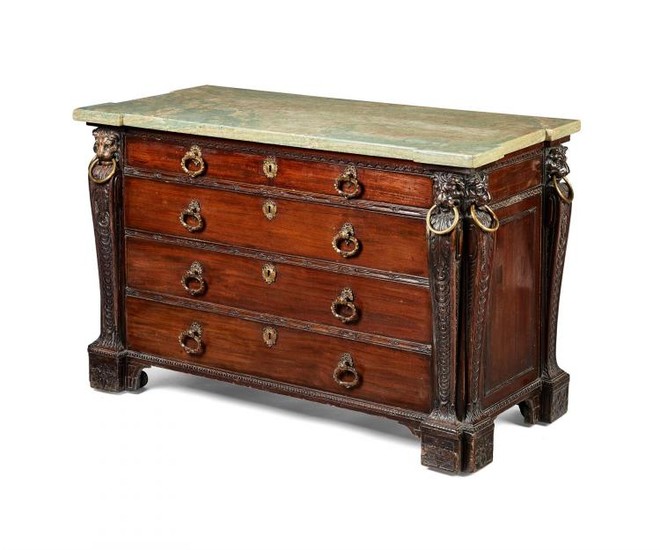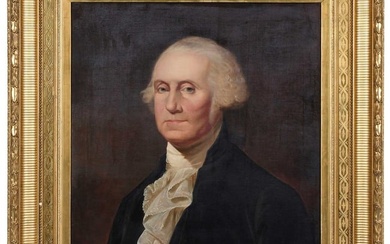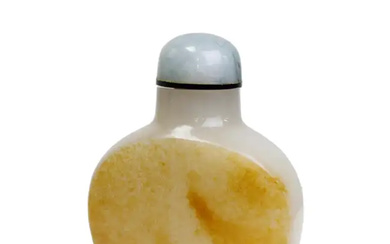A Fine George II carved mahogany, dressing commode, circa 1735, possibly by John Boson and Cornelius Martin or Benjamin Goodison
A Fine George II carved mahogany, dressing commode, circa 1735, possibly by John Boson and Cornelius Martin or Benjamin Goodison,now with an eared rectangular green marble slab top, the four long graduated drawers with original gilt-brass handles and escutcheons, flanked by a pair of guilloche-carved corbel pilasters headed by acanthus leaves and lion masks holding brass rings, the panelled sides with further conforming pilasters, on paterae-carved bracket feet, 80cm high, 123cm wide, 54cm deep, the drawer retaining a label with ducal coronet above a monogram contained within roundel bearing the motto `honi soit qui mal y pense', the back bearing a small paper label 'LADY LEVER COLLECTION' together with the inventory number 'X3933' and another paper manuscript label 'KENT ROOM S. RIGHT', the back also with chalk inscriptions `518 NX' and 'C185',originally with a fold-over top and pull-out supporting front pilasters; the top drawer probably originally fitted.
Provenance:
'M. Harris & Sons, sold 17 June 1920 (£350) to William Lever, 1st Viscount Leverhulme (1851-1925)
The Leverhulme Collection.
The Lady Lever Art Gallery, Port Sunlight.
Sold Christie's London, 27 May 1965, Lot 74 (£472.10s)
The architectural form of the present lot, featuring distinctive lion mask pilasters with brass ring handles, relates to a group of documented 18th furniture associated with the furniture makers John Boson (d.1743) and Benjamin Goodison or Cornelius Martin (d.1767). Both makers were associated with the celebrated Royal architect designer William Kent (d.1745) who was the protégé of Richard Boyle, 3rd Earl of Burlington. The group includes the 'Owl' tables supplied by Boson for the Summer Parlour at Chiswick House in 1735 (See. T. Rosoman, 'The decoration and use of the principal apartments at Chiswick House 1727-7-`, Burlington Magazine, October 1985). Another related desk from Viscount Downe's collection at Wynham Abbey, Yorkshire, is illustrated in F. L. Hinckley, Metropolitan Furniture of the Georgian Years, New York, 1988, p. 78, pl. 44, fig. 93. A further library table supplied to 2nd Duke of Montague for Montague House, Northamptonshire, circa 1737-41 has been traditionally attributed to Goodison on the basis of invoices supporting the assertion that Goodison was the principal cabinet-maker to the Duke. However the discovery of payments in the Montagu accounts to John BosonSummer Exhibition Catalogue, 1987) calls this into question. A George II gilt-brass mounted and marble topped commode attributed to either Boson or Goodison, with provenance from the Dukes of Northumberland, sold Sotheby's, London, 'Treasures including selected works from the collections of the Dukes of Northumberland', 9 July 2014, lot 7.
Shortly prior to the sale of this lot, a much anticipated exhibition William Kent: Designing Georgian Britain, was held at the Bard Graduate Center, New York in September 2013. This gave rise to certain key items being conserved before being loaned to either the Bard Graduate Center or the Victoria& Albert Museum where the exhibitions were staged consecutively first in New York and followed by London. Included in the conservation was the aforementioned Owl Suite, by John Boson, comprising a pair of mahogany and parcel-gilt dressing commodes and companion gilt pier glasses. The evidence for the suite's attribution to Boson is based on a receipt dated 11 September 1735, made out to Lady Burlington who had commissioned the complete furnishing of her Garden Room (later referred to as the Summer Parlour) at Chiswick House. During the course of the 'Owl' dressing commodes conservation, their Victorian leather-lined tops were removed in order to reveal the original top surfaces of the commodes. Interestingly this revealed fragments of a green textile, likely to have been a silk velvet fabric matching that of the green silk damask decorating the walls of the Garden Room at Chiswick during the 1730s. However the most exciting discovery lay to the underside of one of the commodes in the form of faint pencil signatures with the inscriptions 'W. Kent', 'B' standing for John Boson and lastly that of 'Cornelius Martin / 1735'. The latter may be the same Cornelius Martin who was recorded at Dover Street in 1763 (See Geoffrey Beard and Christopher Gilbert, The Dictionary of English Furniture Makers 1660-1840, 1986, p. 580). Hence the 'Owl' commodes would represent the first documented examples of his work. The geographical proximity of Dover Street to Savile Row where Boson had taken a lease for a plot since 1733/1734 (from his patron Lord Burlington), makes this collaboration appear highly feasible. (see Matthew Hirst 'Conservation Discoveries: "New Insights into Lady Burlington's 'Owl' tables for her Garden Room at Chiswick", Furniture History, 2014, pp. 205-215).
John Boson's career was relatively short (See Virtue Note Book, III, Walpole Society, 22, Oxford, 1934, for an obituary recording Boson's death in 1743)dying at 'an age not considerably above middle age'. It was also noted that he was 'a man of great ingenuity and undertook great works in his way for the prime people of quality and made his fortune well in the world'. Tradition has it that Boson's first apprenticeship was as a ship's carver, possibly at Deptford, prior to acquiring his own yard at Greenwich in the early 1720s. His earliest known documented work was for the Duke of Kent in 1727 when he undertook carving at 4 St. James's Square. Significantly the majority of Boson's known commissions were for carved work in wood and marble rather than cabinet-work. His documented furniture is limited to a small group seven surviving pieces. These include the aforementioned 'Owl Suite', now at Chatsworth, and a pair of candle-stands with 'Boys heads' also commissioned by the Burlingtons.
Condition Report:
Marks, scratches and abrasions commensurate with age and use. Some old chips and splits. Some old repairs. Some small losses. This commode is constructed in mahogany, deal and oak, in common with similar pieces from the same school of commode. The three lower drawers are oak lined, the upper drawer is mahogany lined and was originally fitted with compartments. The upper drawer was also originally fitted with a slide, possibly incorporating a rising mirror. The carcase sides and upper dust-board show evidence of the previous positioning of stopping devices for the fitted drawer and slide. The drawer locks appear original and of a high-quality, with three pins and chamfered edges. The gold-lacquered brass drop-handles and backplates appear original also. The brass rings in the lion's mouths are possibly original but may be associated. The bracket feet appear to be largely original and are designed accommodate castors. The iron and lignum castors currently in position are 19th century and associated. The small metal axles positioned into each of the front lion monopodia indicate the original presence of roller castors to enable the withdrawal of the lion-headed terms. Movable monopodia are not unknown on related pieces and almost certainly exist to support a fold-over top. The folding half of the top is no longer present, however repairs at the front left and right corners of the fixed top would indicate the original presence of hinges. The bases of the monopodia are now secured with later screw-fixings but wear to the edges of the carcase previously exposed by the withdrawal of the monopodia can be seen. Plugged holes on either side of the carcase indicate the original presence of carrying handles, now missing. The abraded surface and softened appearance of the lion-headed term monopodia, together with the remains of gesso on the inside front edges of the carcase and splashes onto the backboards probably indicate that the carved elements have at some time been gilded (not originally), and the gilding and gesso has been scrubbed away since The carved detail to the drawer rails, and possibly to other areas may have been later executed and possibly at the time of the parcel-gilding. The finish remaining is largely a shellac coating. Overall, this commode appears to be basically of George II manufacture, however has been aggrandised at some time with the addition of parcel-gilding and possibly some carved details. The commode has also previously retained a fold-over top (now lacking), with the front monopodia withdrawing as supports (now fixed) The current marble top is a later associated addition. The later associated marble top with some chips of loss. There is a slightly larger chip to the rear left corner and to two of the corner edges of the shaped outset element of the marble at the front left corner of the top. Please refer to additional images for visual reference to condition.
View it on
Sale price
Estimate
Time, Location
Auction House
A Fine George II carved mahogany, dressing commode, circa 1735, possibly by John Boson and Cornelius Martin or Benjamin Goodison,now with an eared rectangular green marble slab top, the four long graduated drawers with original gilt-brass handles and escutcheons, flanked by a pair of guilloche-carved corbel pilasters headed by acanthus leaves and lion masks holding brass rings, the panelled sides with further conforming pilasters, on paterae-carved bracket feet, 80cm high, 123cm wide, 54cm deep, the drawer retaining a label with ducal coronet above a monogram contained within roundel bearing the motto `honi soit qui mal y pense', the back bearing a small paper label 'LADY LEVER COLLECTION' together with the inventory number 'X3933' and another paper manuscript label 'KENT ROOM S. RIGHT', the back also with chalk inscriptions `518 NX' and 'C185',originally with a fold-over top and pull-out supporting front pilasters; the top drawer probably originally fitted.
Provenance:
'M. Harris & Sons, sold 17 June 1920 (£350) to William Lever, 1st Viscount Leverhulme (1851-1925)
The Leverhulme Collection.
The Lady Lever Art Gallery, Port Sunlight.
Sold Christie's London, 27 May 1965, Lot 74 (£472.10s)
The architectural form of the present lot, featuring distinctive lion mask pilasters with brass ring handles, relates to a group of documented 18th furniture associated with the furniture makers John Boson (d.1743) and Benjamin Goodison or Cornelius Martin (d.1767). Both makers were associated with the celebrated Royal architect designer William Kent (d.1745) who was the protégé of Richard Boyle, 3rd Earl of Burlington. The group includes the 'Owl' tables supplied by Boson for the Summer Parlour at Chiswick House in 1735 (See. T. Rosoman, 'The decoration and use of the principal apartments at Chiswick House 1727-7-`, Burlington Magazine, October 1985). Another related desk from Viscount Downe's collection at Wynham Abbey, Yorkshire, is illustrated in F. L. Hinckley, Metropolitan Furniture of the Georgian Years, New York, 1988, p. 78, pl. 44, fig. 93. A further library table supplied to 2nd Duke of Montague for Montague House, Northamptonshire, circa 1737-41 has been traditionally attributed to Goodison on the basis of invoices supporting the assertion that Goodison was the principal cabinet-maker to the Duke. However the discovery of payments in the Montagu accounts to John BosonSummer Exhibition Catalogue, 1987) calls this into question. A George II gilt-brass mounted and marble topped commode attributed to either Boson or Goodison, with provenance from the Dukes of Northumberland, sold Sotheby's, London, 'Treasures including selected works from the collections of the Dukes of Northumberland', 9 July 2014, lot 7.
Shortly prior to the sale of this lot, a much anticipated exhibition William Kent: Designing Georgian Britain, was held at the Bard Graduate Center, New York in September 2013. This gave rise to certain key items being conserved before being loaned to either the Bard Graduate Center or the Victoria& Albert Museum where the exhibitions were staged consecutively first in New York and followed by London. Included in the conservation was the aforementioned Owl Suite, by John Boson, comprising a pair of mahogany and parcel-gilt dressing commodes and companion gilt pier glasses. The evidence for the suite's attribution to Boson is based on a receipt dated 11 September 1735, made out to Lady Burlington who had commissioned the complete furnishing of her Garden Room (later referred to as the Summer Parlour) at Chiswick House. During the course of the 'Owl' dressing commodes conservation, their Victorian leather-lined tops were removed in order to reveal the original top surfaces of the commodes. Interestingly this revealed fragments of a green textile, likely to have been a silk velvet fabric matching that of the green silk damask decorating the walls of the Garden Room at Chiswick during the 1730s. However the most exciting discovery lay to the underside of one of the commodes in the form of faint pencil signatures with the inscriptions 'W. Kent', 'B' standing for John Boson and lastly that of 'Cornelius Martin / 1735'. The latter may be the same Cornelius Martin who was recorded at Dover Street in 1763 (See Geoffrey Beard and Christopher Gilbert, The Dictionary of English Furniture Makers 1660-1840, 1986, p. 580). Hence the 'Owl' commodes would represent the first documented examples of his work. The geographical proximity of Dover Street to Savile Row where Boson had taken a lease for a plot since 1733/1734 (from his patron Lord Burlington), makes this collaboration appear highly feasible. (see Matthew Hirst 'Conservation Discoveries: "New Insights into Lady Burlington's 'Owl' tables for her Garden Room at Chiswick", Furniture History, 2014, pp. 205-215).
John Boson's career was relatively short (See Virtue Note Book, III, Walpole Society, 22, Oxford, 1934, for an obituary recording Boson's death in 1743)dying at 'an age not considerably above middle age'. It was also noted that he was 'a man of great ingenuity and undertook great works in his way for the prime people of quality and made his fortune well in the world'. Tradition has it that Boson's first apprenticeship was as a ship's carver, possibly at Deptford, prior to acquiring his own yard at Greenwich in the early 1720s. His earliest known documented work was for the Duke of Kent in 1727 when he undertook carving at 4 St. James's Square. Significantly the majority of Boson's known commissions were for carved work in wood and marble rather than cabinet-work. His documented furniture is limited to a small group seven surviving pieces. These include the aforementioned 'Owl Suite', now at Chatsworth, and a pair of candle-stands with 'Boys heads' also commissioned by the Burlingtons.
Condition Report:
Marks, scratches and abrasions commensurate with age and use. Some old chips and splits. Some old repairs. Some small losses. This commode is constructed in mahogany, deal and oak, in common with similar pieces from the same school of commode. The three lower drawers are oak lined, the upper drawer is mahogany lined and was originally fitted with compartments. The upper drawer was also originally fitted with a slide, possibly incorporating a rising mirror. The carcase sides and upper dust-board show evidence of the previous positioning of stopping devices for the fitted drawer and slide. The drawer locks appear original and of a high-quality, with three pins and chamfered edges. The gold-lacquered brass drop-handles and backplates appear original also. The brass rings in the lion's mouths are possibly original but may be associated. The bracket feet appear to be largely original and are designed accommodate castors. The iron and lignum castors currently in position are 19th century and associated. The small metal axles positioned into each of the front lion monopodia indicate the original presence of roller castors to enable the withdrawal of the lion-headed terms. Movable monopodia are not unknown on related pieces and almost certainly exist to support a fold-over top. The folding half of the top is no longer present, however repairs at the front left and right corners of the fixed top would indicate the original presence of hinges. The bases of the monopodia are now secured with later screw-fixings but wear to the edges of the carcase previously exposed by the withdrawal of the monopodia can be seen. Plugged holes on either side of the carcase indicate the original presence of carrying handles, now missing. The abraded surface and softened appearance of the lion-headed term monopodia, together with the remains of gesso on the inside front edges of the carcase and splashes onto the backboards probably indicate that the carved elements have at some time been gilded (not originally), and the gilding and gesso has been scrubbed away since The carved detail to the drawer rails, and possibly to other areas may have been later executed and possibly at the time of the parcel-gilding. The finish remaining is largely a shellac coating. Overall, this commode appears to be basically of George II manufacture, however has been aggrandised at some time with the addition of parcel-gilding and possibly some carved details. The commode has also previously retained a fold-over top (now lacking), with the front monopodia withdrawing as supports (now fixed) The current marble top is a later associated addition. The later associated marble top with some chips of loss. There is a slightly larger chip to the rear left corner and to two of the corner edges of the shaped outset element of the marble at the front left corner of the top. Please refer to additional images for visual reference to condition.





